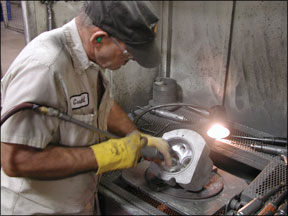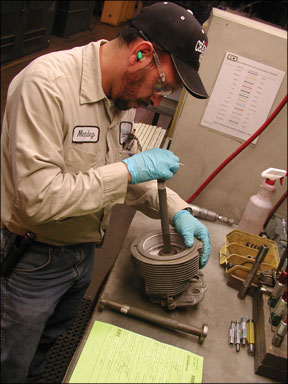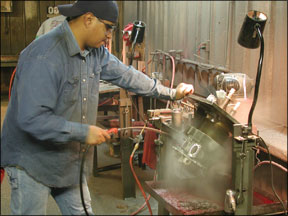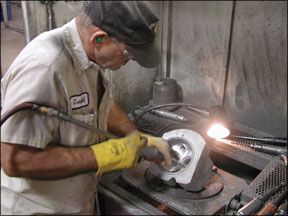Th

in a largish hall closet and runouts have more value as scrap metal than as rebuild cores.The demise of the cylinder overhaul business was an inevitable consequence of the overall decline in GA. As Lycoming and Continental saw their new engine business shrink, they got into the overhaul game and that translated into fierce competition in the cylinder market. The upshot is that for some engines, a new cylinder costs only a few bucks more than an overhauled jug.
“Its usually a no-brainer to go with new,” says Charlie Melot, of Zephyr Aircraft Engines, a leading overhaul shop in Zephyrhills, Florida. Nonetheless, as do many overhaul shops, Zephyr still does cylinder overhauls and still buys and installs overhauled cylinders from the exchange pool. And despite the price plummet in factory cylinder prices and intense competition in new cylinders from Superior and ECI, there’s still a place for overhauled jugs. But given the retraction in the market, buyers need to explore the options carefully before opting for overhauled jugs.
Cherry Picking
The choice of new versus overhauled is driven nearly entirely by price and that in turn is driven by engine population. The more of a particular engine model there is in the field, the more likely that Superior and ECI offer aftermarket PMAd replacement jugs, which has forced the factories mainly Lycoming to lower prices to respond to the competition.

But, for obvious reasons, these companies have cherry picked the market for new cylinder business. There’s little point for an aftermarket house to spend a basket of money to develop a PMA cylinder for an engine model that will generate a few dozen or even a few hundred sales a year. These companies go for the big numbers, leaving the factories to support the low-volume business, with captive-market pricing as an inevitable consequence.
For instance, when Zephyr recently overhauled the Continental TSIO-360 in our Mooney 231, we had two choices for cylinders: factory new or overhauled. There are no aftermarket cylinders for our engine. Prices vary by overhaul source, but TCMs new cylinders cost $1482 each, while the overhauls were $900. (We bought six new cylinders.)
Had we owned a Piper Archer, however, with its parallel-valve 180-HP Lycoming, we would have had four choices: New from the factory for $1000, new from ECI the Titan line for $891, new Millennium cylinders from Superior for $999 or overhauled cylinders for about $800. Add it up, and the price Delta between new and overhauled cylinders is $800 on an engine overhaul costing $15,000 total. This is the no-brainer Charlie Melot was talking about. Penn Yan Aeros Bill Middlebrook told us most owners easily grasp the economics of new versus overhauled cylinders, although some owners require nudging. Middlebrook says Penn Yan almost always recommends new cylinders in instances where competitively priced PMAd cylinders are available and will use overhauls only if the customer insists.
The Case for Overhauls

But its not always so simple. Suppose the owner suffers a one soft cylinder and a second looking a little spongy two-thirds of the way to TBO. The shop recommends a complete top overhaul, perhaps surmising that if two jugs are bad, the rest cant be far behind. But logic like that is hardly inescapable and concluding that the other cylinders will fail just because two already have is pure crystal-ball gazing.
In this case, the owner might think buying a new set of cylinders would be cost effective, since he can then re-use them when the engine reaches TBO. Unfortunately, those cylinders cant simply be removed and re-used in the new overhaul, since the engine overhaul specs specifically require a number of cylinder components to be replaced valve guides, bushings, studs, rings and so on, regardless of condition. So even though the newish cylinders may be still be shiny and at new part limits, the owner will have to overhaul or replace them.
In our view, a situation like this argues strongly for repairing cylinders or overhauling them selectively, even if it means buying an overhauled jug or two from the cylinder pool. Proactive replacement of good cylinders that might fail is a high-dollar option thats just as likely to be money unnecessarily spent as it is a wise investment in sustained reliability. This may vary by engine. Some turbocharged engines are routinely topped just past mid-time and wise owners budget for it. But that doesnt mean all have to be topped.
In our view, absent some global trashing from corrosion, cylinders that look good at 1200 or 1400 hours with strong compression and clean bores stand a good chance of making it another 400 to 600 hours without tanking, especially if the engine is flown frequently. Selective replacement of just one problem cylinder gives the owner a financial breather while monitoring the remaining cylinders, plus time to think about a point-of-no-return if another cylinder goes soft. At that point, cutting losses and buying an early overhaul may be the best option.
The Repair Option
Given the overwhelming trend toward new cylinders, if overhauls have gotten a bad name, repaired cylinders are even more besmirched in some circles. Yet, there are hundreds of perfectly serviceable cylinders out there that have been removed from engines for various reasons some by flush owners spending money proactively. If the circumstances are right, we see no reason not to repair a cylinder for re-use or even buy one from the yellow-tagged pool.
The circumstances might be thus: Youre at 1600 hours on a 2000-hour engine and a valve guide tanks, taking the compression down to 50 pounds. A full top makes no economic sense and an early overhaul prompted by one crumped cylinder doesnt make much more, absent other factors. But an overhauled jug or a repaired one might be the most cost-effective perfect fit.
Some shops will repair cylinders on the spot, or send them out for repair. One we’ll regarded shop used by many overhaul facilities is J&J Airparts in Pleasanton, Texas, south of San Antonio. J&J is a custom house and will do work including replacing guides or seats, honing a barrel, replacing studs or valves or welding cracks. J&Js James Woltaske told us repairs are constrained by the minimal financial headroom between fixing a cylinder and replacing or overhauling it. “If I cant save you at least $200,” he says, “then Im not doing you a service.”
Another cost and time-effective option is to simply buy a yellow-tagged cylinder that has been inspected, repaired (if necessary) and deemed airworthy. Some shops keep a few yellow-tagged cylinders on the shelf for just such demand, albeit limited, and one shop that keeps quite a stock of what it calls IRAN cylinders is Certified Engines in Opa Locka, Florida.
Certifieds IRANs that means inspect and repair as necessary sell for an attractive fraction of the cost of even an overhauled cylinder. You cant, of course, use these in a fresh engine overhaul, but theyre an appealing choice when an otherwise strong engine needs a crutch to finish out the TBO run or you need a get-home solution for an AOG engine.
Overhaul High Points
Although the cylinder overhaul business is a shadow of what it once was, engine shops tell us that this hasnt translated into survival of the fittest. You don’t have to look hard at all to find a $200 cylinder overhaul.
“Whats been done in a $200 overhaul?” says Penn Yans cylinder supervisor, Alex Courtney. “I don’t know, but I can tell you, its not much.” As with the engine itself, cylinder overhauls can be done to new limits or to service limits.
Reputable shops provide new limits overhauls and in our estimation, these are the only overhauls worthy of purchase for a full engine overhaul. It may not always make sense to install a new cylinder, but it makes a lot less sense to install a crummy overhaul.
A good cylinder overhaul starts with a breakdown of the cylinder for cleaning and inspection. Sometimes, this involves demating the head from the barrel, as at ECI, or a “head-on” overhaul, which is what field shops and J&J do.
The barrel bore is inspected for corrosion or other damage and can be bored 0.010-inch oversize for Lycoming cylinders and 0.015-inch for Continental cylinders. The entire cylinder head is dye penetrant inspected for cracks, especially around spark plug bosses and critical valve seat areas. If the cylinder has significant stepping near the top of the bore that boring wont remove, it can be plated and rebored. Not long ago, channel chrome plating of cylinder bores was the best choice for corrosion protection but for environmental reasons, chroming is declining, displaced by the nickel carbide plating process pioneered by ECI. Nickel carbide Cermi-Nil is ECIs trade name has proven popular with owners for its excellent wear and anti-corrosion characteristics. Some shops RAM Aircraft in Waco, Texas, for instance have reported such good performance with Cermi-Nil that they have even factory new cylinders treated.
Other shops use Cermi-Nil selectively or at customer request. As an add-on, it costs about $150 per cylinder. (Well feature a detailed report on Cermi-Nil in the February issue of
Aviation Consumer.)A proper new limits overhaul requires the replacement of valves and valve seats and guides, exhaust studs, bushings, pistons and rings. Springs and keepers and other valve train parts can be used legally, but better overhaulers replace them, too. Some reputable shops re-use the intake valve but replace the exhaust valve. A service limits cylinder overhaul will re-use some of these parts, based on service limit condition.
Next to the cylinder bore, the condition of the cylinder head is the next most critical consideration in cylinder overhauls. Its common to find cracking in cylinder heads ECI says 90 percent of overhauled heads are cracked. Neither Lycoming nor Continental approve of welding cracks and why would they? Theyre interested in selling new cylinders. But the reality is, most overhauled cylinders are welded. (See the sidebar.)
Conclusions
If you opt for overhauled cylinders for whatever reason price or availability an overriding concern is this: Will they last as long as a new cylinder might? The simple answer is no one knows. “Common sense,” says ECIs Ed Salmeron, “would tell you that the new cylinder is more likely to make TBO.” All metal parts have fatigue life limits and these may vary by how the engine was treated during its service life. On the other hand, many cylinders are overhauled more than once so some obviously deliver the same service as new cylinders do.
From a strictly financial point of view, it makes little sense to use overhauls on a parallel valve Lycoming where prices of new cylinders are so competitive. The price disparity is greater on angle-valve Lycomings and might amount to $2000 or more on the cost of the complete engine job. Thats not chump change. The Continental market is different, since ECI and Superior compete intensely, but the factory offers above-the-fray prices. For instance, on an O-470, a set of new cylinders will cost $3000 more than a set of overhauls.
We would be inclined to consider overhauls only on non-turbocharged engines where the price variance is at least $500 per cylinder and then only if the overhaul shop applies the same warranty to new and overhauled cylinders. (Reputable shops do.)
That means two things: You have some coverage in the event the cylinders don’t perform as expected and the shop doing the engine overhaul has a strong interest in either performing the cylinder overhauls correctly itself or finding a vendor who can. That knocks some of the sting off the potential risk of using overhauled jugs and may make the savings all the sweeter.





